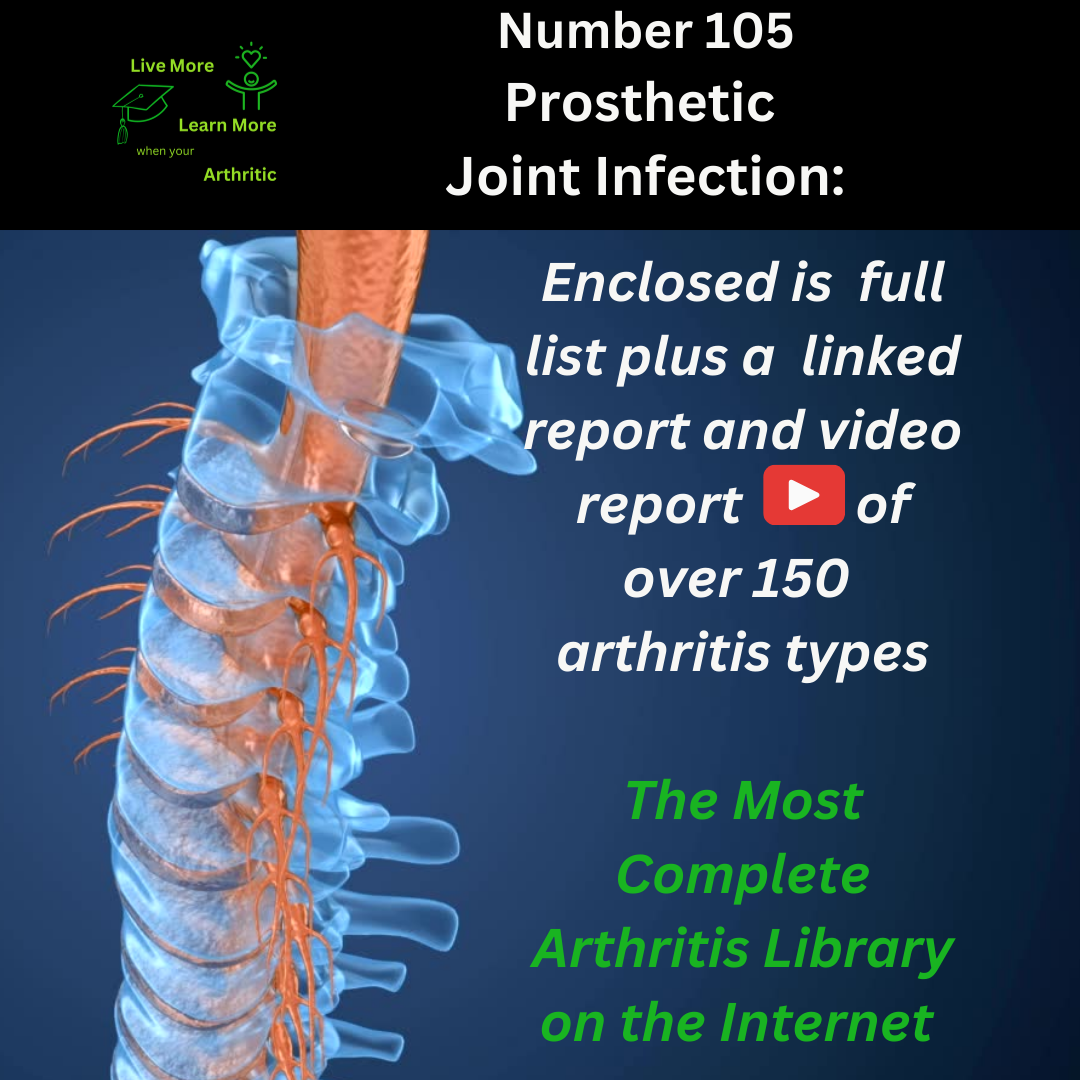
Prosthetic Joint Infection: Number 105 of around 150 types of Arthritis
Navigating the Challenges of Prosthetic Joint Infection: A Tale of Resilience and Renewal
Enter the realm of prosthetic joint infection, where innovation meets adversity. Join us on a journey to understand this condition, exploring its impact on the body and the potential for proactive management.
 The Affected Anatomy: Unveiling Joint Vulnerabilities
The Affected Anatomy: Unveiling Joint Vulnerabilities
Prosthetic joint infection primarily affects artificial joints, including hips, knees, shoulders, and elbows. These vital connections, once bolstered by prosthetic components, become vulnerable to microbial invasion.
Pursuing Progress: Embracing Remission and Resolution
Can prosthetic joint infection retreat into remission? With prompt diagnosis, targeted antibiotic therapy, and possibly surgical intervention, remission is achievable. However, vigilance is paramount to prevent recurrence.
Decoding the Disorder: Causes and Culprits of Infection
What triggers this joint turmoil? Prosthetic joint infection often results from bacterial colonization during surgery or through hematogenous spread from distant infections. Factors like diabetes, obesity, or immunosuppression can increase susceptibility.
Symptoms Unmasked: The Joint’s Silent Struggle
How does prosthetic joint infection manifest itself? Symptoms include pain, swelling, warmth, redness around the joint, fever, and limited range of motion. These signs underscore the body’s battle against microbial invasion.
The Age Angle: Onset and Expectations
Who’s most susceptible to this joint ordeal? While it can occur at any age, older adults undergoing joint replacement surgeries are at higher risk. Underlying health conditions and surgical history play pivotal roles.
Lifespan Lamentations: Impact on Mobility and Wellness
Does prosthetic joint infection shorten life expectancy? Generally, it doesn’t affect lifespan directly, but it can significantly impair mobility and quality of life if left untreated or if complications arise.
Autoimmune Anecdotes: Is This Arthritis’s Alter Ego?
Is prosthetic joint infection autoimmune in nature? No, it’s an infectious complication following joint replacement rather than an autoimmune disorder. However, immunocompromised individuals are more vulnerable.
Risk Factors Revealed: Unveiling Joint Health Vulnerabilities
Who’s at risk of developing prosthetic joint infection? Individuals with diabetes, rheumatoid arthritis, or prior joint infections face higher risks. Obesity, smoking, and prolonged steroid use also increase susceptibility.
Complications Conundrum: Navigating Joint Health Fallout
What perils accompany this joint condition? Complications may include chronic pain, joint instability, implant loosening, septicemia, or even life-threatening systemic infections if left unmanaged.
The Swell and Soreness: Inflammation’s Impact
Is swelling a hallmark of prosthetic joint infection? Yes, infection triggers inflammatory responses, leading to joint swelling, warmth, and discomfort, reflecting the body’s defense against microbial invasion.
Tender Tendons: Feeling the Weight of Joint Infection
Do tender joints accompany infection? Absolutely. Infected joints become tender to the touch, often accompanied by pain and stiffness that impede daily activities.
Cartilage Concerns: The Ripple Effect on Joint Integrity
Why does cartilage matter in this context? Infection can erode joint cartilage, compromising joint integrity and mobility, necessitating comprehensive management strategies.
Comorbidity Considerations: Interconnected Health Realities
Are there related conditions to watch for? Prosthetic joint infection may coexist with diabetes, immunodeficiency, or chronic inflammatory diseases, highlighting the need for holistic health assessments.
Embracing Proactivity: Elevating Joint Health and Quality of Life
Can proactive measures improve life with prosthetic joint infection? Absolutely. Timely diagnosis, tailored antibiotic therapy, surgical debridement, and lifestyle modifications can mitigate symptoms and enhance joint function.
Complications Unveiled: Pathways to Joint Awareness
What perils await those unprepared? Chronic joint pain, implant failure, recurrent infections, and compromised mobility are among the potential ramifications of untreated or persistent prosthetic joint infection.
Demographic Dimensions: Who’s Most Affected?
Who bears the brunt of prosthetic joint infection? It affects both genders, often impacting older adults undergoing joint replacement surgeries, with men slightly more predisposed due to higher rates of joint surgeries.
 Connected Conditions: Recognizing Health Alliances
Connected Conditions: Recognizing Health Alliances
Are there intertwined diseases to consider? Prosthetic joint infection may be associated with osteomyelitis or septic arthritis, emphasizing the importance of comprehensive infectious disease evaluations.
In conclusion, while prosthetic joint infection presents formidable challenges, proactive management and tailored interventions can pave the way towards improved joint health and quality of life. Each step towards understanding and proactive care offers hope and resilience in the face of joint health complexities, illuminating pathways towards joint restoration and renewed vitality.

